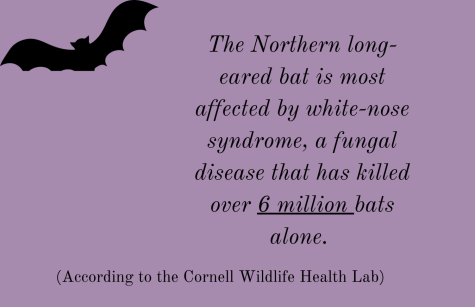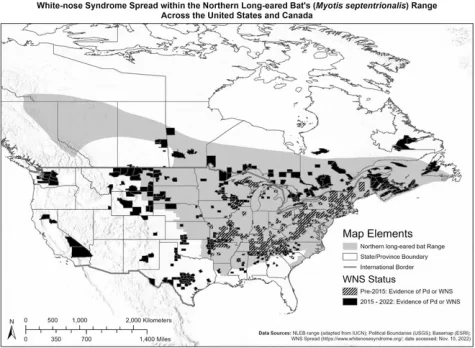U.S. Bat Species Now Endangered from Fungal Disease

The Northern long-eared bat (Mytosis septenrionalis) Creds: Center for Biological Diversity
December 2, 2022
In the United States alone, there are over 45 bat species. Over half of them are endangered, and another species has joined this roster. The Northern long-eared is now officially recognized as an endangered species, and will be under protection.
The fungal disease, white-nose syndrome, has caused large declines in bat populations since 2006, and data from summer showed an 80% decline across the bats’ range (from 2010-2019).
“Northern long-eared bats living in Indiana facing extinction, are now listed as endangered,” according to Star Press writer Karl Schneider. “This fungus grows on the exposed skin of bats and causes damage. Infected bats will wake early from hibernation before food sources are plentiful and rapidly deplete energy stores and eventually starve and die.”

Once a bat becomes infected with white-nose syndrome, there is no cure. Mammologist Brad Westrich has stated that the fungus has pretty much already spread to every cave in Indiana, where the fungus was found in 2011.

Spokeswoman for USFWS Georgia Parham states, “There’s research, monitoring, and experimental types of testing going on to look at vaccines and other treatments… Canada is involved, too. It’s a huge undertaking by not only the government community but also conservation organizations and academic organizations to try to find a solution to this.”
Why is this such a big issue? What do these bats do, anyway? Well, in Indiana specifically, Northern long-eared bats (and all bats in general) eat only insects, especially crop pests, which keep the insect population manageable and saves farmers and tree lot owners tons of money that would be spent on pesticides typically. In the Western areas of the United States, bats eat nectar, which allows native plants to grow and pollinate naturally.
Norco high sophomore Myla Alexander exclaims, “I didn’t even know that bats had infections this severe. I really hope a cure is found, that’s so sad and I hope they’ll be okay.”
Centennial high senior Mikey Rubio says, “I’ve been researching this recently, actually. I want to become a certified mammologist and be able to prevent outbreaks like this. Hopefully we can do something to bring the population numbers back up.”
Many bat species are devastated by diseases and infections, but most are not as severe as this. If you’d like to support bat species world wide and are able to donate or simply want to learn more, make sure to visit Bat Conservation International’s website, http://batcon.org.

